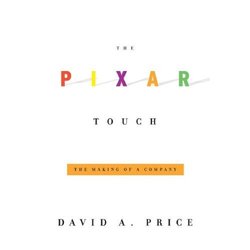Source of book image:
http://bp2.blogger.com/_Sar8IPNlxOY/SClPS33oTxI/AAAAAAAAB_0/B8GjajHtetY/s1600/PixarTouch.jpg
(p. A19) One of Mr. Catmull’s other inspirations was to hire computer animator John Lasseter after he was fired by Walt Disney Co. in 1983. (He had apparently stepped on one too many toes in the company’s sprawling management structure.) Then again, as Mr. Price reports, in the world of computer animators, workplace comings and goings seemed to be part of the job. Mr. Lasseter himself had already quit Disney and then returned before being fired. In the creative ferment of computer animation in the late 1970s and early 1980s, what mattered most was the work itself: Never mind who signs the paychecks – what project are you working on now?
. . .
One of Pixar’s first projects revealed a truth that would point the way to success: Storytelling is more important than graphics firepower. The company created a short film, directed by Mr. Lasseter, called “Tin Toy,” about a mechanical one-man band fleeing the terrors of a baby who wants to play with it. “Tin Toy” made audiences laugh in part because it turned established themes on their heads. The story was told from the toy’s-eye view, close to the floor. The baby, doing what babies do, seemed like a gigantic, capricious monster. “Tin Toy” won the 1988 Academy Award for animated short film.
The upside-down “Tin Toy” point of view seems to fit much of what happened at Pixar afterward. The company made a deal with Disney in 1991: The little animation outfit would produce three movies, and the entertainment behemoth would distribute and market them. With the outsize success of the first movie in the deal, “Toy Story” – it grossed $355 million world-wide – Pixar and Disney were perhaps on an inevitable collision course over control and profits. Mr. Price adroitly depicts the clashes between Mr. Jobs and his nemesis at Disney, chief executive Michael Eisner, and captures the sweet vindication of Mr. Lasseter as the projects he guides outstrip the animation efforts of his former employer.
The sweetest moment in the Pixar saga came two years ago, when Disney bought the company for $7.4 billion in an all-stock deal – one that gave Pixar executives enormous power at their new home. Mr. Jobs sits on the Disney board and is the company’s largest shareholder. (Mr. Eisner left in 2005.) And Mr. Lasseter became the chief creative officer for the combined Disney and Pixar animation studios, where Mr. Catmull serves as president.
The day after the sale was announced, Mr. Lasseter and Mr. Catmull flew to Burbank, Calif., to address a crowd of about 500 animation staffers on a Disney soundstage. “Applause built as they made their way to the front,” Mr. Price reports, “and then erupted again in force” when the two men were introduced. “Lasseter was welcomed as a rescuer of the studio from which he had been fired some twenty-two years before.” In one of their first moves, Mr. Price says, Messrs. Lasseter and Catmull “brought back a handful of Disney animation standouts who had only recently been laid off.” Redemption, after all, is essential to any story well told.
For the full review, see:
PAUL BOUTIN. “Bookshelf, An Industry Gets Animated.” The Wall Street Journal (Weds., May 14, 2008): A19.
(Note: ellipsis added.)


